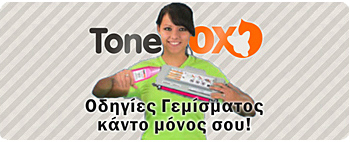
Κατά την έρευνα αγοράς ένός εκτυπωτή, οι καταναλωτές μπορούν να επιλέξουν ανάμεσα σε δύο τύπους εκτυπωτών: εκτυπωτές inkjet ή εκτυπωτές λέιζερ. Και οι δύο τύποι έχουν τα πλεονεκτήματα και τα μειονεκτήματά τους. Θα επωφεληθείτε περισσότερο από τα πλεονεκτήματα εάν αποφασίσετε κατά τη στιγμή της αγοράς για έναν εκτυπωτή που ανταποκρίνεται καλύτερα στις απαιτήσεις εκτύπωσης και λαμβάνοντας υπόψη τις ατομικές ανάγκες όπως χαμηλό θόρυβο, οικονομική κατανάλωση ενέργειας και υλικών εκτύπωσης κ.λπ. Επίσης, δεν πρέπει να πληρώσετε για να έχει ο εκτυπωτής λειτουργίες που άλλοι τις χρειάζονται εσάς όμως προσωπικά δεν σας χρειάζονται.
ΕΚΤΥΠΩΤΕΣ INKJET
Οι εκτυπωτές inkjet είναι οι πιο δημοφιλείς σε ιδιώτες δηλαδή για απλή χρήση στο σπίτι. Έχοντας μια τέτοια συσκευή στο σπίτι, δεν χρειάζεσται πλέον της υπηρεσίες του φωτογραφικού εργαστηρίου της γειτονιάς. Οι φωτογραφίες, τα σχέδια και άλλες εικόνες με γραφικά που τυπώνονται σε έναν εκτυπωτή inkjet και σε ειδικό χαρτί είναι εξαιρετικής ποιότητας και μπορεί να έχουν επαγγελματική όψη. Ένας εκτυπωτής inkjet καταναλώνει πολύ λίγη ενέργεια σε καταστάση αναστολής λειτουργίας (λέγετε και sleep ή power saver ή standby mode) και επομένως είναι πολύ δημοφιλής σε ιδιωτικά νοικοκυριά. Στα θετικά των εκτυπωτών inkjet είνα η τιμή αγοράς και η τιμές για τα Μελανοδοχεία που είναι χαμηλές αλλά και η χρήση τους είναι αρκετά οικονομική. Ωστόσο, με έναν εκτυπωτή inkjet, πρέπει να αποδεχτείτε μια χαμηλότερη ταχύτητα εκτύπωσης, επειδή οι εκτυπωτής inkjet τυπώνουν γραμμή προς γραμμή και όχι ολόκληρη την εικόνα ή τη σελίδα ταυτόχρονα όπως ο εκτυπωτής λέιζερ. Επίσης, δεν πρέπει να αφήνετε τον εκτυπωτή σας inkjet αχρησιμοποίητο για μεγάλο χρονικό διάστημα, καθώς αυτό θα προκαλέσει το στέγνωμα του Μελανοδοχείου, με αποτέλεσμα ο εκτυπωτής να μην μπορεί να εκτυπώσει. Επιπλέον, οι αυτοματοποιημένες διαδικασίες καθαρισμού που δεν μπορείτε να επηρεάσετε χρησιμοποιούν πρόσθετο μελάνι για τον καθαρισμό των κεφαλών εκτύπωσης.
Έτσι, τα Μελανοδοχεία (εκτυπωτές inkjet) πρέπει να αλλάζονται συχνότερα από τον γραφίτη (εκτυπωτές λέιζερ).
Λαμβάνοντας υπόψη το γεγονός ότι πρέπει να χρησιμοποιείται ειδικό χαρτί κατά την εκτύπωση φωτογραφιών, η τιμή ανά εκτύπωση για τον εκτυπωτή inkjet είναι συνολικά υψηλότερη από ό,τι για τον εκτυπωτή laser. Επίσης, εάν είναι σημαντική για εσάς η μεγαλύτερη διάρκεια ζωής της εκτύπωσης, πρέπει να γνωρίζετε ότι οι εκτυπωτές inkjet δεν διαρκούν πολύ και εξωτερικές επιρροές, όπως σταγονίδια νερού ή το φως του ήλιου, επηρεάζουν σε μεγαλύτερο βαθμό την ποιότητα των εικόνων.
Όσον αφορά τη φιλικότητα προς το περιβάλλον, οι εκτυπωτές inkjet υπερτερούν των λέιζερ, καθώς χρησιμοποιούν λιγότερη ηλεκτρική ενέργεια και δεν εκπέμπουν μικροσκοπικά σωματίδια που θα μπορούσαν να είναι επικίνδυνα για την ανθρώπινη υγεία.
Πλεονεκτήματα εκτυπωτών inkjet:
- Χαμηλό κόστος απόκτησης- Εξαιρετική ποιότητα εικόνας
- Χαμηλή κατανάλωση ενέργειας
- Δεν προκαλούν βλάβες στους ανθρώπους ή στο περιβάλλον από την σκόνη τόνερ που εκλύουν
- Κατάλληλο για έγχρωμες εικόνες
Μειονεκτήματα εκτυπωτών inkjet:
- Υψηλότερο κόστος ανά εκτυπωμένη σελίδα- Αργή ταχύτητα εκτύπωσης
- Τα έγχρωμα δοχεία στεγνώνουν με την πάροδο του χρόνου
ΕΚΤΥΠΩΤΕΣ LASER
Οι εκτυπωτές λέιζερ εντυπωσιάζουν με την υψηλή ταχύτητα εκτύπωσης και ως εκ τούτου προτιμούνται σε μεγάλα γραφεία, που τους χρησιμοποιούν για να αποφευχθούν οι ουρές αναμονής στον εκτυπωτή. Το συνήθως ογκώδες σχήμα της συσκευής του εκτυπωτή είναι λιγότερο ενοχλητικό. Η ασπρόμαυρη εκτύπωση όπως είναι τα κείμενα που παράγουν οι εκτυπωτές λέιζερ είναι εξαιρετικής ποιότητας, το κόστος για το χαρτί είναι χαμηλό. Το κόστος κάθε μεμονωμένης εκτύπωσης είναι επίσης πολύ χαμηλότερο από ό,τι όταν χρησιμοποιείται τεχνολογία inkjet. Οι εκτυπώσεις λέιζερ είναι αρκετά ανθεκτικές, ακόμα κι αν το χαρτί εκτίθεται στον ήλιο ή την υγρασία.
Ωστόσο, οι εκτυπωτές λέιζερ και τα φωτοαντιγραφικά θα πρέπει να τοποθετούνται σε καλά αεριζόμενους χώρους, καθώς οι συσκευές εκπέμπουν σκόνη γραφίτη και σωματίδια τόνερ, τα οποία μπορούν να προκαλέσουν αλλεργικές αντιδράσεις σε επαφή με το δέρμα και τους βλεννογόνους.
Πλεονεκτήματα εκτυπωτών λέιζερ:
- Υψηλή ταχύτητα εκτύπωσης- Ακριβής ασπρόμαυρη εκτύπωση
- Χαμηλό κόστος ανά εκτυπωμένη σελίδα
- Οι εκτυπώσεις επηρεάζονται λιγότερο σχετικά με τους inkjet από τον ήλιο και την υγρασία
- Δεν χρειάζεται να αλλάζετε συχνά τα Μελανοδοχεία
- Οι κασέτες τόνερ δεν στεγνώνουν
- Εκτός από το ειδικό χαρτί για εκτυπωτές inkjet, στους λέιζερ μπορούν να χρησιμοποιηθούν σχεδόν όλοι οι τύποι χαρτιού
Μειονεκτήματα εκτυπωτών λέιζερ:
- Υψηλό κόστος απόκτησης- Υψηλή κατανάλωση ενέργειας
- Οι εκτυπωτές λέιζερ εκλύουν μικροσκοπικά σωματίδια τα οποία, ανάλογα με την ποσότητα του αέρα που εισπνέεται, μπορεί να είναι επιβλαβή
- Μέτρια ποιότητα έγχρωμων εκτυπώσεων (κατώτερη των inkjet)
Αυτές οι αλλαγές στην απόχρωση, είναι όμως τόσο μικρές και ανεπαίσθητες, πού διορθώνονται πολύ εύκολα με μικρή προσαρμογή στις ρυθμίσεις διαχείρισης χρωμάτων στο μενού ή στο πρόγραμμα οδήγησης (driver) του εκτυπωτή.
Κατά κανόνα ισχύουν γενικά τα παρακάτω:
1. Κασέτες Τόνερ, που έχουν ενσωματωμένο τον κύλινδρο τυμπάνου, δεν θα πρέπει να ξαναγεμίζονται περισσότερο από 1 φορά διότι το τύμπανο είναι από τα τμήματα εκείνα που φθείρονται ιδιαίτερα.
2. Κασέτες Τόνερ, που έχουν έναν "κύλινδρο μεταφοράς τόνερ" από λάστιχο, δεν θα πρέπει να ξαναγεμίζονται περισσότερο από 3 φορές, και η απόφαση εξαρτάται αποκλειστικά από το αν ο ελαστικός "κύλινδρος μεταφοράς τόνερ" έχει πριν από το γέμισμα φθορές όπως μικρές γρατσουνιές ή χτυπήματα. Ιδιαίτερα αν μία τέτοια κασέτα έχει αποθηκευτεί για μεγάλο διάστημα είναι πολύ πιθανόν η ελαστική επιφάνια του "κυλίνδρου μεταφοράς τόνερ" να έχει χάσει την ελαστικότητά της, να έχει σκληρύνει και να μην δίνει ικανοποιητικές εκτυπώσεις.
3. Κασέτες Τόνερ που εμφανίζουν διαρροές και χάνουν τόνερ λόγο των πολλών αναγομώσεων, δεν θα πρέπει να ξαναγεμίζονται.
Σε ορισμένους τύπους εκτυπωτών, όπως η σειρά της Lexmark C520 οι αρχικές κασέτες τόνερ (starter Cartridges) είναι έτσι σχεδιασμένες ώστε να παίρνουν μόνο μία μικρή ποσότητα τόνερ. Σε αυτή την περίπτωση, δεν πρέπει να αδειάσουμε όλη τη φιάλη, στην κασέτα με μία φορά, αλλά να την γεμίσουμε σε περισσότερα στάδια.
Για παράδειγμα, ο κατασκευαστής των εκτυπωτών Hewlett-Packard αναφέρει ρητά στους όρους εγγύησης: "Στους εκτυπωτές, η χρήση ή προμήθεια αναλώσιμων από άλλους κατασκευαστές δεν περιορίζει την κάλυψη της εγγύησης." Άλλοι κατασκευαστές εκτυπωτών μπορεί να μην είναι τόσο σαφής στη διατύπωση, αλλά δεν υπάρχουν ρήτρες που να ακυρώνουν την εγγύηση από τη χρήση συμβατών κασετών.
Εξαίρεση αποτελεί: Νομικώς κρίσιμο είναι αν μπορέσει ο κατασκευαστής να αποδείξει εμφανέστατα και με σαφήνεια ότι η βλάβη δεν δημιουργήθηκε από υλικά που κατασκευάζονται απ αυτόν. Έτσι, αναφέρει π.χ. η HP: "Αν ωστόσο η κακή λειτουργία ή βλάβη στο σύστημα του εκτυπωτή, μπορεί να αποδοθεί στη χρήση αναλωσίμων συμβατών ή ξαναγεμισμένων από άλλους προμηθευτές ή άλλους κατασκευαστές, τότε η HP για να διορθώσει ή να επισκευάσει των εκτυπωτή ή το συγκεκριμένο ελάττωμα, το κόστος των υπηρεσιών όπως τα εργατικά και το πρόσθετο κόστος ανταλλακτικών που ίσως χρειαστούν δεν καλύπτετε από την εγγύηση και χρεώνεται στον χρήστη."
Ωστόσο κατά πάσα πιθανότητα για λόγους χρόνου, γιατί πρέπει να γίνουν οι κατάλληλες δοκιμές (και αυτές είναι αρκετές) για να διαπιστωθεί αυτό, υπάρχει μία χαλαρότητα των τεχνικών στο θέμα αυτό.
Αν μια άδεια κασέτα που έχει Τσιπ την γεμίσουμε και την εισάγουμε στον εκτυπωτή χωρίς να αλλάξουμε το Τσιπ ο εκτυπωτής θα κλειδώσει και δεν θα τυπώνει έως ότου τοποθετήσουμε καινούργιο Τσιπ στην κασέτα (με πολύ λίγες εξαιρέσεις).
Στις κασέτες χωρίς Τσιπ ισχύει στις περισσότερες των περιπτώσεων ότι συνήθως έχουν κάποιο στέλεχος (πλαστικό τμήμα π.χ. βραχίονα ή μοχλό) που αντικαθιστά την λειτουργία του Τσιπ. Στην πράξη βέβαια ένα Τσιπ είναι πολύ πιο δύσκολο να παρακαμφθεί, από ένα μοχλό ή από ένα βραχίονα, γι αυτό και τελευταία σχεδόν όλοι οι κατασκευαστές, τοποθετούν στις κασέτες τους αυτά τα λεγόμενα "έξυπνα" Τσιπ.
Επίσης τον τελευταίο καιρό βλέπουμε όλο και πιο συχνά, μοντέλα εκτυπωτών που στις αρχικές κασέτες (starter Cartridges) αυτές δηλαδή που συνοδεύουν τον εκτυπωτή με την αγορά του, δεν έχουν Τσιπ. Στις περισσότερες των περιπτώσεων αυτές οι κασέτες δεν γεμίζονται γιατί δεν μπορεί να τοποθετηθεί το Τσιπ (πολλές φορές τους λείπει και η βάση τοποθέτησης του Τσιπ ή και κάποιο άλλο εξάρτημα που υπάρχει στις κασέτες του εμπορίου) αν και υπάρχουν και εδώ πάλι μερικές εξαιρέσεις.
Οι περισσότερες κασέτες δυστυχώς προστατεύονται από ένα πρόσθετο αισθητήρα ο οποίος ανιχνεύει τα επίπεδα του τόνερ τα οποία και αποθηκεύει στην μνήμη του Τσιπ. Εφόσον ο αισθητήρας κρίνει ότι η ποσότητα του τόνερ που έχει απομένει στην κασέτα δεν είναι αρκετή για να εκτυπώσει κανείς κλειδώνει το τσιπ, έτσι το Τσιπ μηδενίζεται, χωρίς να μπορεί αυτή η διαδικασία να ακυρωθεί ή να αντιστραφεί ακόμη και αν μετέπειτα γεμίσουμε την κασέτα με τόνερ, η κασέτα θα δείχνει στον εκτυπωτή ότι είναι άδεια.
Για τον λόγο αυτό συνιστάμε πάντα, να γίνεται πλήρες γέμισμα της κασέτας και ταυτόχρονα να τοποθετείτε το νέο Τσιπ, έτσι όλα θα πηγαίνουν καλά και δεν θα έχουμε προβλήματα.




